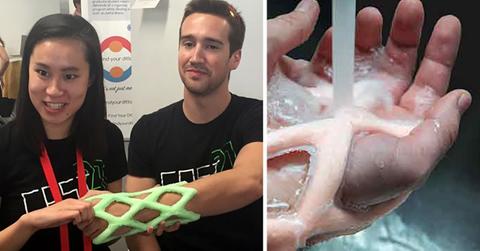Engineering Students Create Waterproof and Lightweight Arm Cast to Replace Plaster Casts
Updated June 12 2023, 10:33 a.m. ET

If you've ever had to wear a plaster cast, you'll know what a pain it is. They're heavy, you have to put a plastic bag over them when you shower, and when they're eventually taken off the smell is something else.
But if a Chicago-based startup has its way, the pain of plaster would be a thing of the past. Cast21 is looking to change the way we mend broken bones and it's about time.
Cast21's wide mesh sleeve can be slipped onto the patient's wrist and is then filled with a liquid resin that quickly hardens and sets the bone in place.
Jason Troutner, biomedical design engineer Ashley Moy, and electrical engineer Justin Brooks from the University of Illinois came up with the idea after partnering up for an engineering design class according to ZME Science.
They want to replace the plaster cast, which can make a patient's skin feel itchy. Itching underneath the unhygienic plaster cast can cause sores and even lead to infection.
This wouldn't be an issue with Cast21 as it's far more breathable and hygienic.
Veronica Hogg, Cast21's vice president of engineering, told the Daily Mail: "We have this radical notion that you can enjoy your healing experience. You don't need to be restrained from daily activities."
According to the Daily Mail, fitting a cast could take as little as ten minutes.
First, a doctor or nurse would measure the limb. Once they've selected the right sized cast, they put it on the limb and fill it with a mix of resins. After the sleeve is full, it only takes about three minutes for the cast to become malleable.
Doctors can then mold the cast to fit the patient's limb, and then wait another five minutes for the resin to harden fully.
It's also far easier to remove than traditional casts, which requires doctors to use a circular saw.
Hogg added: "The majority of fractures happen in children, adolescents and the elderly."
"Those saws are very loud and all this debris flies off and it's very messy, it can be extremely frightening. The cast saw also presents a risk of burns to the patient."
"Our product does not require that at all. It's designed so that a physician can take clinical shears, snip through the tabs and pull it open easily."
"It was designed to completely eliminate the use of a cast saw and make the healing process far more pleasant for the patient."
Hogg explained that the device isn't painful to apply, and the resin hardening can even provide benefits.
"It feels soothing," Hogg added. "It reaches about the same temperature as a hot tub."
"Another bonus is that no electricity or water is needed to apply our cast, so it's very portable."
"It has potential for use in the military and for at-home first aid."
"I'm from Colorado and I like to go hiking, the equipment needed to administer our cast is so small and lightweight that hikers and climbers could carry it with them in their backpacks."
The cast is still a ways off, with the company only designing a forearm model in a medium size. They hope to be able to create casts for legs as well.
Hogg added: "The idea is to prove that this technology works right now, we are past the prototype stage and have a fully functioning model in place for the forearm."
"We hope this technology can span across the entire body. We are looking forward to having a lower limb model for ankle fractures soon."
"With the technology, we can also do a longer arm model or a model that goes up to the fingers as well."
While there's currently no price, they hope to be able to make it as available to as many people as possible.
"We don't want this to be a luxury product," Hogg explained. "We are still conducting research in price sensitivity, and the final cost to the patients will be depending on their insurance and doctor."